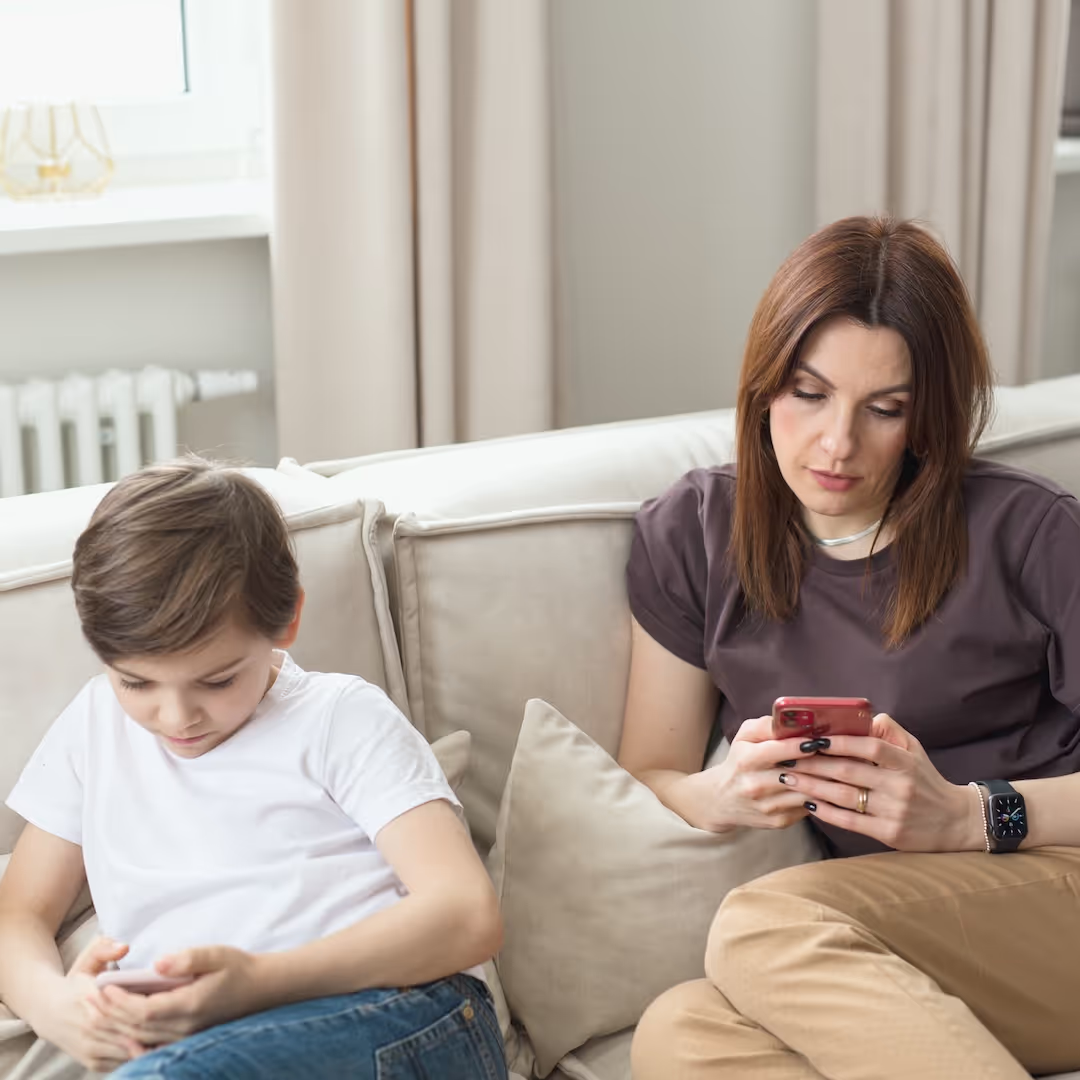



The ding of incoming texts on your kid’s phone is more than an annoyance and distraction. It could actually be a sign of compulsive or addictive behavior. Here are a few indicators of compulsive texting from a study published in the October 2015 issue of the Psychology of Popular Media Culture:
The study examined the texting habits of 400 8th and 11th graders and the impact of those behaviors on academic performance. Compulsive texting is defined by more than just sending a large number of texts. It also includes trying to decrease texting without success, defensiveness about use of texting and frustration when unable to text.
As Kelly M. Lister-Landman, the paper’s lead author and an assistant professor of psychology at Delaware County Community College in Media, PA commented in a New York Times article,
“What is [texters’] relationship with phone use? Do they feel anxious when it’s not around them? When they sit down to eat dinner with their family, do they feel a need to check it? Do they feel compelled to look at it at all times, rather than just answering texts they get?”
Parents of girls should pay particular attention to this issue as compulsive texting has more negative academic consequences for adolescent girls, despite the fact that their overall academic functioning is higher than adolescent boys. The study notes that texting may create more anxiety and social distress for girls than boys and that the content of girls’ texts may be more distracting, thus leading to texting’s greater impact on their academic performance.
The study recommends that parents put the following safeguards in place:
This is where a contract with your kid can be a great tool. Click here for Screenager’s contracts.
http://www.apa.org/pubs/journals/releases/ppm-ppm0000100.pdf
Here is a video from the Screenagers YouTube Channel that talks more about this subject
Learn more about showing our movies in your school or community!
Join Screenagers filmmaker Delaney Ruston MD for our latest Podcast

Learn more about our Screen-Free Sleep campaign at the website!
Our movie made for parents and educators of younger kids
Learn more about showing our movies in your school or community!
Learn more about showing our movies in your school or community!
Join Screenagers filmmaker Delaney Ruston MD for our latest Podcast

Learn more about our Screen-Free Sleep campaign at the website!
Our movie made for parents and educators of younger kids
Join Screenagers filmmaker Delaney Ruston MD for our latest Podcast
As we’re about to celebrate 10 years of Screenagers, we want to hear what’s been most helpful and what you’d like to see next.
Please click here to share your thoughts with us in our community survey. It only takes 5–10 minutes, and everyone who completes it will be entered to win one of five $50 Amazon vouchers.

The ding of incoming texts on your kid’s phone is more than an annoyance and distraction. It could actually be a sign of compulsive or addictive behavior. Here are a few indicators of compulsive texting from a study published in the October 2015 issue of the Psychology of Popular Media Culture:
The study examined the texting habits of 400 8th and 11th graders and the impact of those behaviors on academic performance. Compulsive texting is defined by more than just sending a large number of texts. It also includes trying to decrease texting without success, defensiveness about use of texting and frustration when unable to text.
As Kelly M. Lister-Landman, the paper’s lead author and an assistant professor of psychology at Delaware County Community College in Media, PA commented in a New York Times article,
“What is [texters’] relationship with phone use? Do they feel anxious when it’s not around them? When they sit down to eat dinner with their family, do they feel a need to check it? Do they feel compelled to look at it at all times, rather than just answering texts they get?”
Parents of girls should pay particular attention to this issue as compulsive texting has more negative academic consequences for adolescent girls, despite the fact that their overall academic functioning is higher than adolescent boys. The study notes that texting may create more anxiety and social distress for girls than boys and that the content of girls’ texts may be more distracting, thus leading to texting’s greater impact on their academic performance.
The study recommends that parents put the following safeguards in place:
This is where a contract with your kid can be a great tool. Click here for Screenager’s contracts.
http://www.apa.org/pubs/journals/releases/ppm-ppm0000100.pdf
Here is a video from the Screenagers YouTube Channel that talks more about this subject
Sign up here to receive the weekly Tech Talk Tuesdays newsletter from Screenagers filmmaker Delaney Ruston MD.
We respect your privacy.

The ding of incoming texts on your kid’s phone is more than an annoyance and distraction. It could actually be a sign of compulsive or addictive behavior. Here are a few indicators of compulsive texting from a study published in the October 2015 issue of the Psychology of Popular Media Culture:
The study examined the texting habits of 400 8th and 11th graders and the impact of those behaviors on academic performance. Compulsive texting is defined by more than just sending a large number of texts. It also includes trying to decrease texting without success, defensiveness about use of texting and frustration when unable to text.
As Kelly M. Lister-Landman, the paper’s lead author and an assistant professor of psychology at Delaware County Community College in Media, PA commented in a New York Times article,
“What is [texters’] relationship with phone use? Do they feel anxious when it’s not around them? When they sit down to eat dinner with their family, do they feel a need to check it? Do they feel compelled to look at it at all times, rather than just answering texts they get?”
Parents of girls should pay particular attention to this issue as compulsive texting has more negative academic consequences for adolescent girls, despite the fact that their overall academic functioning is higher than adolescent boys. The study notes that texting may create more anxiety and social distress for girls than boys and that the content of girls’ texts may be more distracting, thus leading to texting’s greater impact on their academic performance.
The study recommends that parents put the following safeguards in place:
This is where a contract with your kid can be a great tool. Click here for Screenager’s contracts.
http://www.apa.org/pubs/journals/releases/ppm-ppm0000100.pdf
Here is a video from the Screenagers YouTube Channel that talks more about this subject

It feels like we’re finally hitting a tipping point. The harms from social media in young people’s lives have been building for far too long, and bold solutions can’t wait any longer. That’s why what just happened in Australia is extremely exciting. Their new nationwide move marks one of the biggest attempts yet to protect kids online. And as we released a new podcast episode yesterday featuring a mother who lost her 14-year-old son after a tragic connection made through social media, I couldn’t help but think: this is exactly the kind of real-world action families have been desperate for. In today’s blog, I share five key things to understand about what Australia is doing because it’s big, it’s controversial, and it might just spark global change.
READ MORE >
I hear from so many parents who feel conflicted about their own phone habits when it comes to modeling healthy use for their kids. They’ll say, “I tell my kids to get off their screens, but then I’m on mine all the time.” Today I introduce two moms who are taking on my One Small Change Challenge and share how you can try it too.
READ MORE >
This week’s blog explores how influencers and social media promoting so-called “Healthy” ideals — from food rules to fitness fads — can quietly lead young people toward disordered eating. Featuring insights from Dr. Jennifer Gaudiani, a leading expert on eating disorders, we unpack how to spot harmful messages and start honest conversations with kids about wellness, body image, and what “healthy” really means.
READ MORE >for more like this, DR. DELANEY RUSTON'S NEW BOOK, PARENTING IN THE SCREEN AGE, IS THE DEFINITIVE GUIDE FOR TODAY’S PARENTS. WITH INSIGHTS ON SCREEN TIME FROM RESEARCHERS, INPUT FROM KIDS & TEENS, THIS BOOK IS PACKED WITH SOLUTIONS FOR HOW TO START AND SUSTAIN PRODUCTIVE FAMILY TALKS ABOUT TECHNOLOGY AND IT’S IMPACT ON OUR MENTAL WELLBEING.
